Originally posted by:I'm up to date but think I'm good. I clicked start menu, and in the search bar typed something, then while results were still displayed and processes seemed normal at 3% cpu usage on idle.Good to check, I noticed some other systems went fine, but a few have this problem.The one affected was:Windows 10 - 64 BitNvidia RTX 2080 TiWith the latest Nvidia Graphic card drivers.
I mention this because the 'SearchUI.exe' under Cortana / Search Bar starts to use the GPU 0 - 3D process. It seems to be trying to off-load some of it's processing to the graphics card.It reports nothing is corrupted on the system files, etc. However, will just continuously waste processing and memory building up an search index file 2GB+ (this can keep increasing in size). Originally posted by:Narrowed it down to those that had previously 'disable Cortana' and/or the 'Bing call-out' on local searches (for privacy reasons), before updating to this patch.Some people have also mentioned it freezes their games or even the Steam Client.Basically anyone using shutup10 that has disabled cortana will not want to install this update intill they iron out this bug, luckily it's a optional update for now. And to think of all those times I was told it was safe to use it.

I’m using the workaround just in case though.
I reciently upgraded from SQL Server 2000 to SQL Server 2008.I've noticed an unusually high CPU utilization from SQL server.Under activity monitor, I'm seeing about 4 UPDATE STATISTICS commands starting at state SUSPENDED, then to RUNABLE, then to RUNNING. Those UPDATE STATISTICS commands are updating the stats on the largest table in our database. Could those commands be the cause of my high CPU utilization?I have:auto create stats = trueauto update stats = trueauto update stats async = falseAlso, in our nightly database maintenance plan, I have update statistics, reorganize index and rebuild index tasks setup. Each night the maintenance plan is successful, but these commands take the longest to execute 3 hours, 3 hours and 5 hours respectivelly.Server Configuration:MS SQL Server 2008 EnterpriseWindows Server 2003 Standard SP2Index Xeon dual core 2.8Ghz, 2GB ram. Hi,You must understand how SQL Server updates statistics 'in-fly' to choose what to do.When you set auto update stats to true, and auto update statistics async to false.Assuming a query using a certain index is executing. If more than 20% of that index has been 'touched' since last update stats operation, the optimizer will suspend the query, re compute stats, and then elaborate a plan to run your query.
Thanks Fabrice,Actually, I'm not concerned about the performance of queries run agains the database. I don't have any applications currently running on the database nor have I experienced any performance issues running a query on the largest table in the db.My concern here is that SQL server is running an UPDATE STATISTICS command because auto update statistics is turned on. This UPDATE STATISTICS command is utilizing alot of CPU.Since I'm rebuilding and reorganizing indexes nightly, could that be the reason why SQL server is automatically running UPDATE STATISTICS?What can I do to decrease the time it takes to run UPDATE STATISTICS? I have also an article which explains differences betwwen the sync and async auto update of statistics.I will also add that the term 'asynchronous' doesn't mean that SQL will recompute statistics during low activity.You can schedule jobs in the SQL Agent on condition of processors load. I think it can be an answer to your problem.
(an spupdatestats triggered when processors are used by less than x%.)And when you rebuild an index, statistics are automatically recomputed, as far as the flag 'auto create statistics' is set to true.If you want to know when statistics where computed last time on an object, you can run: dbcc showstatistics(tablename,indexname). I agree that 2GB of RAM is pretty low for any serious SQL Server installation. Are you checking the fragmentation levels for these indexes to see if they need to be reorganized or rebuilt, or are you rebuilding them every night 'just because'?
If you rebuild an index that does not have more than 30% fragmentation, you are generating a lot of unnecessary work for your server and I/O subsystem. The most common scenario is to leave AUTO UPDATE STATISTICS turned on, and to enable AUTO UPDATE STATISTICS ASYNCH. Then, just reorganize or rebuild indexes that are actually fragmented with your maintenance jobs.mark as the answer if this post solved your issue. Hi, Your plan should be something like this: 1.) Identify the Indexes with fragmentation 2.) Reorganise the indexes that has lower fragmentation levels, it really depends on your system as how much you can accept but as a rule of thumb 10% and 30% I would Turn OFF Auto Update Statistics ON, obviously it is a overhead on the server,if you are updating statistics every night OR I would schedule a job to Update stats manually.
Hi,Only 2 years late to the party:) I'm only adding this in as I had a similar problem on a beefier server, the CPU would max out for the duration of the job. I alleviated this by reducing the Max Degree of Parallelism to restrict parallel queries to halfof the cores in my machine (in your case 1, which means no parallel queries, but that might be the trade off between running maintenance and general use. For mine it was 2).

Automatic Updates Causing 100 Cpu Usage Fix
Just another potential solution to the problem if anyone else reads this thread.Stephen.